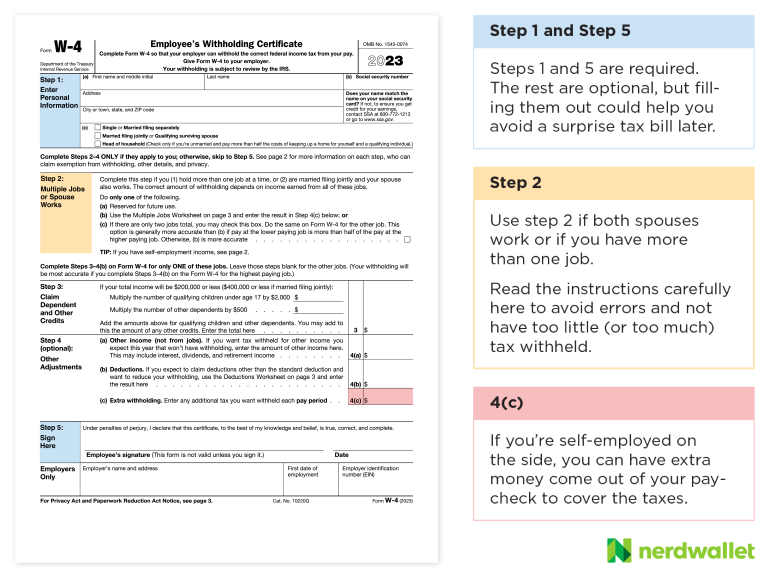What Is a W-4 Form? How to Fill Out an Employee’s Withholding Certificate

Many or all of the products featured here are from our partners who compensate us. This influences which products we write about and where and how the product appears on a page. However, this does not influence our evaluations. Our opinions are our own. Here is a list of our partners and here's how we make money.
What is a Form W-4?
A W-4 form, formally titled "Employee's Withholding Certificate," is an IRS form that tells employers how much tax to withhold from each paycheck. Employers use the W-4 to calculate certain payroll taxes and remit the taxes to the IRS and the state (if applicable) on behalf of employees.
You do not have to fill out the new W-4 form if you already have one on file with your employer. You also don't have to fill out a new W-4 every year. If you start a new job or want to adjust your withholdings at your existing job, though, you'll likely need to fill out the new W-4. Either way, it's a great excuse to review your withholdings.
How to fill out a W-4 form in 2023
Here's how to complete the steps that apply to your situation.
Step 1: Personal information
Enter your name, address, Social Security number and tax-filing status.
Step 2: Account for multiple jobs
If you have more than one job, or you file jointly and your spouse works, follow the instructions to get more accurate withholding.
For the highest paying job’s W-4, fill out steps 2 through 4(b) of the W-4. Leave those steps blank on the W-4s for the other jobs.
If you (or you and your spouse) have a total of two jobs and make roughly the same amount at both, you can instead opt to check box 2(c) to indicate this. The catch: You’ll need to do this on both W-4s.
If you don’t want to reveal to your employer that you have a second job, or that you get income from other non-job sources, you have a few options: On line 4(c), you can instruct your employer to withhold an extra amount of tax from your paycheck. Alternatively, don’t factor the extra income into your W-4. Instead of having the tax come directly out of your paycheck, send estimated tax payments to the IRS yourself instead.
Step 3: Claim dependents, including children
If your total income is under $200,000 (or $400,000 if filing jointly), you can enter how many kids and dependents you have and multiply them by the credit amount. (See the rules about the child tax credit and for when you can claim a tax dependent.) You can also choose to not claim dependents – even if you have them – if you need more taxes taken out of your paycheck to reduce your tax bill.
Step 4: Refine your withholdings
If you want extra tax withheld or expect to claim deductions other than the standard deduction when you do your taxes, you can note that.
Step 5: Sign and date your W-4
Once completed, give the signed form to your employer's human resources or payroll team. You may also be able to fill it out online through your employer's payroll system.
Download Form W-4
Download Form W-4 via the IRS website. You can also access prior-year forms and FAQs here.

What should I put on my W-4?
If you got a huge tax bill when you filed your tax return last year and don’t want another, you can use Form W-4 to increase your withholding. That’ll help you owe less (or nothing) next time you file. If you got a huge refund last year, you’re giving the government a free loan and could be needlessly living on less of your paycheck all year. Consider using Form W-4 to reduce your withholding.
Here are some steps you might take toward a specific outcome:
How to have more taxes taken out of your paycheck
If you want more taxes taken out of your paychecks, perhaps leading to a tax refund when you file your annual return, here's how you might adjust your W-4.
Reduce the number of dependents.
Add an extra amount to withhold on line 4(c).
How to have less tax taken out of your paycheck
If you want less in taxes taken out of your paychecks, perhaps leading to having to pay a tax bill when you file your annual return, here's how you might adjust your W-4.
Increase the number of dependents.
Reduce the number on line 4(a) or 4(c).
Increase the number on line 4(b).
How to use a W-4 to owe nothing on a tax return
If your objective is to engineer your paycheck withholdings so that you end up with a $0 tax bill when you file your annual return, then the accuracy of your W-4 is crucial.
Use the correct tax-filing status. If you file as head of household and haven't updated your W-4 for a few years, for example, you may want to consider filling out a new W-4 if you want the amount of taxes withheld from your pay to more accurately align with your tax liability. (Here's how to choose the right filing status.)
Make sure your W-4 reflects your current family situation. If you had a baby or had a teenager who turned 18 this year, your tax situation is changing and you may want to update your W-4.
Accurately estimate your other sources of income. Capital gains, interest on investments, rental properties and freelancing are just some of the many other sources of non-job income that might be taxable and worth updating on line 4(a) of your W-4.
Accurately estimate your deductions. The W-4 assumes you're taking the standard deduction when you file your tax return. If you plan to itemize (presumably because itemizing will cut your taxes more than the standard deduction will), you'll want to estimate those extra deductions and change what's on line 4(b).
Take advantage of the line for extra withholding. If you want to have a specific number of extra dollars withheld from each check for taxes, you can put that on line 4(c).
Need more help? There are worksheets in the Form W-4 instructions to help you estimate certain tax deductions you might have coming. The IRS’s W-4 estimator or NerdWallet's tax calculator can also help.
Promotion: NerdWallet users get 25% off federal and state filing costs. | |
| |
Promotion: NerdWallet users can save up to $15 on TurboTax. | |
Promotion: NerdWallet users get 30% off federal filing costs. Use code NERD30. |
W-4 calculator
What to keep in mind when filling out Form W-4
1. The W-4 form has changed
In the past, employees could claim allowances on their W-4 to lower the amount of federal income tax withheld from their wages. The more withholding allowances an employee claimed, the less their employer would withhold from their paychecks. However, the 2017 Tax Cuts and Jobs Act overhauled a lot of tax rules, including doing away with personal exemptions. That prompted the IRS to change the W-4 form.
The new W-4, introduced in 2020, still asks for basic personal information, but no longer asks for a number of allowances. Now, employees who want to lower their tax withholding must claim dependents or use a deductions worksheet.
2. Note if you are exempt from withholding taxes.
Being exempt means your employer won’t withhold federal income tax from your pay. (Social Security and Medicare taxes will still come out of your check, though.) Generally, the only way you can be exempt from withholding is if two things are true:
You got a refund of all your federal income tax withheld last year because you had no tax liability, and
You expect the same thing to happen this year.
If you are exempt from withholding, write “exempt” in the space below step 4(c). You still need to complete steps 1 and 5. Also, you’ll need to submit a new W-4 every year if you plan to keep claiming exemption from withholding.
3. File a new W-4 form when life changes.
You can change your W-4 at any time, but if any of these things happen to you during the year you might especially want to update your W-4 so your withholdings reflect your tax life:
You get married or divorced.
You have a kid.
You take a pay cut or get a big raise.
You work only part of the year.
You have a lot of dividend income.
You or your spouse freelance on the side.
4. Get comfortable fiddling with your withholdings.
Tinkering is OK. You're allowed to give your employer a new W-4 at any time. That means you can fill out a W-4, give it to your employer and then review your next paycheck to see how much money was withheld. Then you can start estimating how much you'll have taken out of your paychecks for the full year.
If it doesn't seem like it'll be enough to cover your whole tax bill, or if it seems like it'll end up being way too much, you can submit another W-4 and adjust.
If you want an extra set amount withheld from each paycheck to cover taxes on freelance income or other income, you can enter it on lines 4(a) and 4(c) of Form W-4.









